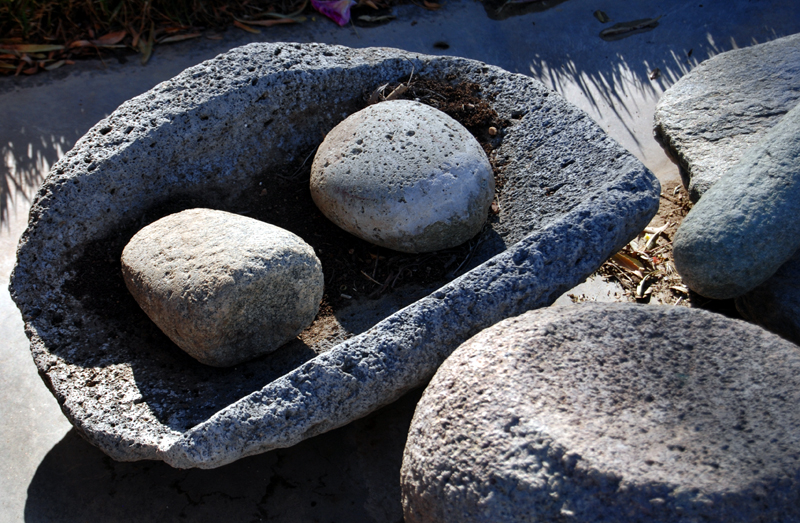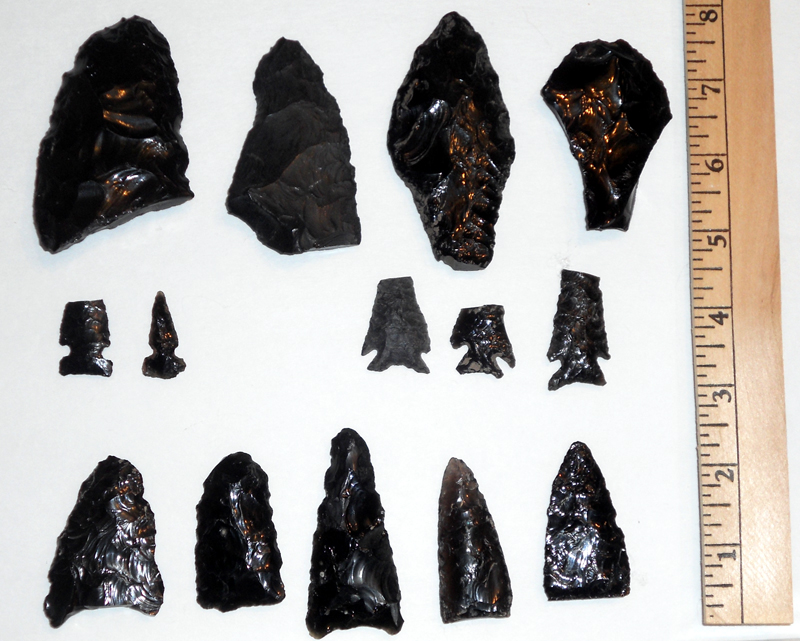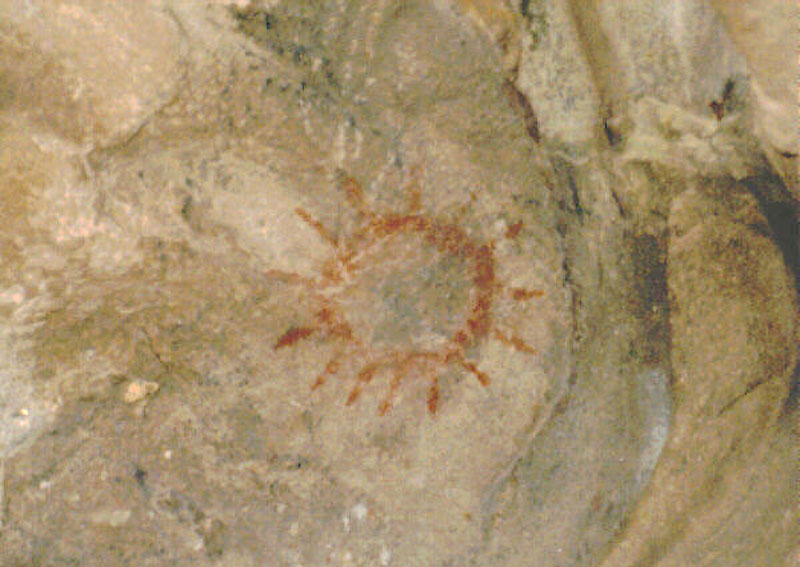|
|
Nature, History to Share Spotlight at New Vasquez Center
By Katalin Szabolcsi
SCVHistory.com | June 21, 2012
Part 1: Interpretive Center Rising at Bandit's Rocky Hideout (5-9-2012)
Part 2: Projects at Vasquez Rocks Emphasize Green Design, Art (5-26-2012)
Part 3: Nature, History to Share Spotlight at New Vasquez Center (6-21-2012)
Part 4: Agua Dulce Artifacts Passing from One Safekeeper to Another (6-21-2012)
Further Reading: Agua Dulce Man Preserves Tataviam Past (10-2-2000)
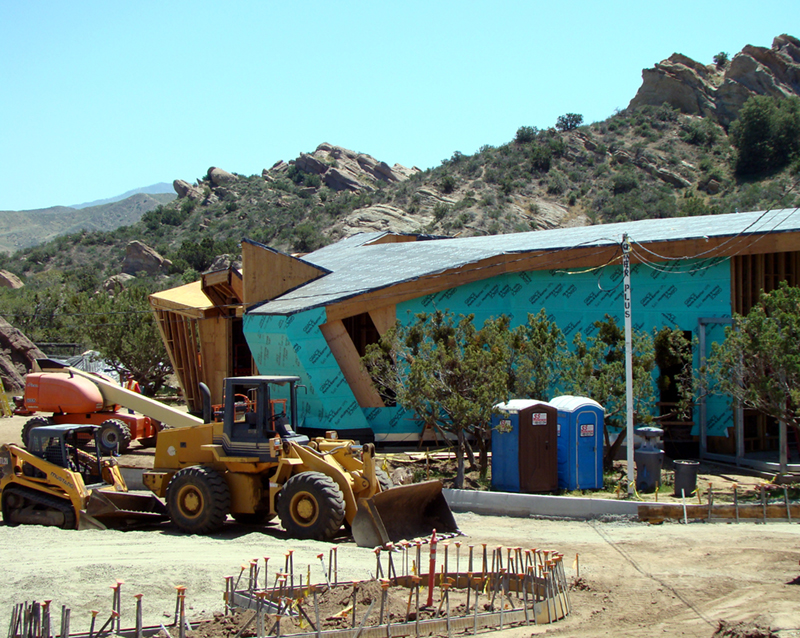
The long-awaited Interpretive Center emerges from the shadows at Vasquez Rocks.
Photo by Leon Worden. Click images to enlarge.
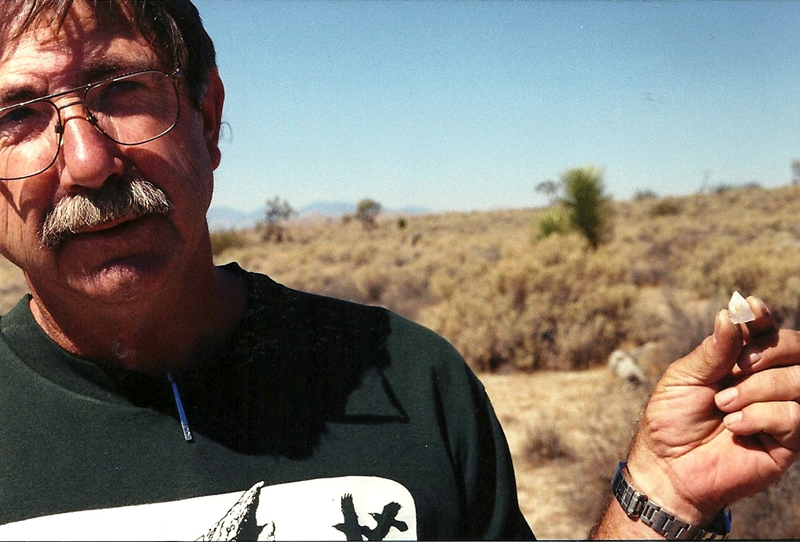
Many Indian artifacts collected by the late Art Brewer will be displayed in the Intepretive Center. Here, Brewer shows how native quartz rock was used in tool making.Four decades in the making, it is finally happening: An Interpretive Center is being built at Vasquez Rocks County Park. It is expected to be open later this year.
"The establishment of the Vasquez Rocks Interpretive Center is a major milestone for those of us who appreciate and study the natural history and the history of the upper Santa Clara Valley area," said Albert Knight, a renowned Southern California archaeologist. "Local residents, students of all ages and visitors will all have the opportunity to look, learn and be inspired, in a comfortable setting, by the bountiful resources of the region."
Vasquez Rocks is the most archaeologically rich park in the Los Angeles County park system. Its boundaries contain several prehistoric human occupation sites, and of course the legend of its namesake, Tiburcio Vasquez. It is also home to a large range of archetypal Southern California flora and fauna.
In the early 1970s another Southland archaeologist, Chester King, performed extensive work at Vasquez Rocks and suggested a museum or interpretive center be erected to protect and promote the area's historical wealth.
Twenty years passed before county officials started the ball rolling. In the mid-1990s the first funding was earmarked for the project, much to the joy of Art Brewer, a member of the Vasquez Rocks Nature Center Associates who had also advocated the construction of a museum dedicated to the park's native American history.
Brewer, of Agua Dulce, had a large collection of artifacts found on private properties in the area and hoped his collection would one day be displayed at Vasquez Rocks.
He didn't live to see the construction of the building he fought for, but his daughter, Sarah, carried on the family tradition.
"Although I wish more than anything my dad could have seen this center," Sarah Brewer said, "I feel that now is the right time for it to finally be built. The original designs for the building were made with love, but they would not have been nearly as efficient as this building."
The facility will be Los Angeles County's most environmentally "secure-proof" project, according to Kaye Michelson, a special assistant with the Los Angeles County Department of Parks and Recreation.
"This building is the first LEED Platinum (building) to be constructed by Los Angeles County," Michelson said. "It will be sustainable and environmentally sensitive."
Platinum is the highest level of "green" construction as defined by the U.S. Green Building Council.
Brewer is clearly a fan of the building's design.
"This building has the perfect amount of style and modernity while maintaining a cohesiveness with the surroundings," she said. "I think that once it is complete, it is really going to shine."
Michelson said the project is funded with $1.27 million from a 1996 state parks bond fund, $109,000 in leftover funds from a 1986 state bond, $3.5 million from county utility users taxes, $1.03 million from vehicle license fees and $3.795 million budgeted by the county last year for Supervisor Michael D. Antonovich's Fifth District.
Construction started a year ago.
"The stumbling blocks for the Interpretive Center have been many and are very emotional," said Brewer. "This is a very passionate community, and although it is rather complicated, all I can say is that everyone has a different opinion on the center, which has made it a long road to where it stands now."
Designs were completed by Gruen Associates, and Brewer said the architects and construction contractors worked closely with the Agua Dulce community. Two years ago the Agua Dulce Town Council appointed a committee to serve as a liaison between the council and the designers and builders. Brewer said the two companies have been "tremendously responsive" to the community's suggestions.
"I was lucky to be a part of this committee," Brewer said, "and we have some really great people on this team. The builders and designers have walked us through, step by step, the design process of this building, and I have a great deal of respect for them because this is a very close-knit community that is very particular about how things are done. That is part of what has kept Agua Dulce the rural gem that it is."
The Interpretive Center will be located near the entrance of the park, just west of the old ranger station, which has been restored and will serve as the park staff office, Michelson said.
Nature, History On Display
Designed to showcase the park's natural and human history, the center will feature several educational facilities and exhibits.
The outside animal enclosures — home to birds such as an American Kestrel (a small falcon), a red-tailed hawk, a red-shouldered hawk and a barn owl — will not be moved, Brewer said, but the building will feature six terrariums that will house several lizard and snake species.
"As far as I know, there will probably be the rosy boa (currently living in the ranger's office), a gopher snake, an alligator lizard, and even a rattlesnake," Brewer said. "We feel it is important to have a venomous and non-venomous snake so that people can see the difference. People tend to kill any snake they see because they think it is going to kill them, when really most of our native snakes are incredible helpers and are harmless to people and pets."
Sarah Brewer participated in the artifact selection process.
"They include an excellent range of artifact types, from grinding stone tools such as manos and metates to projectile points, soapstone pendants and more," she said. "I hope to keep the artifacts rotated on a fairly regular basis to keep things exciting for those who will frequent the building, and to show the excellent range of craftsmanship, material and artifact types."
One piece from her father's collection will stand out: a grooved ax which Dr. John Johnson, curator of anthropology at the Santa Barbara Museum of Natural History, said was not native to California. Made by an Arizona tribe, the Hohokam, its presence is indicative of extensive trade in prehistoric times.
Vasquez Rocks' other prehistoric feature, the native American paintings on some of the rock surfaces, have been off-limits to the public since 1996 in an attempt to preserve them after years of looting, vandalism and erosion, but their replicas will be on display, as well.
"The actual rock art sites are not and will not be available to the public," Michelson said. "They are monitored by staff and have been thoroughly recorded by Sapphos Environmental (an environmental compliance and resource management firm). The entire 932 acres of Vasquez Rocks has been surveyed and recorded by Sapphos Environmental."
Albert Knight, who conducted several studies of the rock art at Vasquez Rocks, said, "The bit about the rock art being vandalized, while true, is a bit overblown. The great enemy is time. Most of the paintings are on very soft sandstones and mudstones, which exfoliate fairly easily."
Tribal Participation
Descendants of the Tataviam Indians — who arrived in the area about 1,500 years ago — have been working closely with the county and park officials ensuring proper care has been taken of the artifacts and the rock art.
One of these descendants is Rudy Ortega Jr., tribal administrator and Tomiar Sahovit (Captain Spiritual Leader) of the Fernandeño Tataviam Band of Mission Indians. Ortega's ancestors were among the Tataviam who, hundreds of years ago, called the hills and valleys of the Santa Clarita Valley home.
"The county contacted the tribe several years back about preserving the rock art," Ortega said. "The County Park folks have done a terrific job in protecting and preserving the site."
He said county officials contacted his tribe more recently to review artifacts and tribal family photos proposed for display.
"I did provide input to several artifacts that the county is planning on using for the Interpretive Center, in how the artifacts were used by Tataviam ancestors," he said.
Ortega also performed a blessing ceremony of the artifacts that were unearthed during grading for the new building, said Brewer.
"It was a wonderful experience," she said. "I am so glad we have their support. They are really great people and so interesting to talk to."
To coincide with the new Interpretive Center's opening, the Vasquez Rocks Nature Center Associates group has also been revitalized.
"The current board is getting everything ready so that new members, and soon a new board, can carry the torch on into the new era at Vasquez," Brewer said. "Membership is expected to be open within the next few months, in time for the opening of the Interpretive Center."
Docent Training
Part of the revitalization process involved training up of a new batch of docents who will lead educational tours for visitors on the park's history, flora and fauna. Nine docents graduated in March: Lanita Algeyer, Bryan Miller, Lisa Smith, Lorraine Stewart, Laura Skorich, Marnye Summers, William Sutton, Denny Truger, and Brewer.
"It has been an absolute pleasure working with these people," Brewer said. "They care so much about this program that they are champing at the bit for the VRNCA. From lichen to wildflowers, to insects and lizards, this group has a wide array of interests and specialties, and will make an amazing group of leaders for children and adults alike."
No opening date has been selected, as it is unknown when the construction will actually finish.
"They are shooting for the end of summer, but with construction there are always hangups, so they are chugging along the best they can," Brewer said.
Ortega said his tribe has been invited to the grand opening.
"I will perform the native blessing for the opening with the Tataviam Singers," he said.
Brewer, who grew up with the museum project at the forefront of her father's penchant for Vasquez Rocks, is excited to see it coming to fruition.
"The community needs this. Schools need this. I feel that this building will provide so much for everyone. Getting people out of the house and into an environment where they can learn is an incredible gift, and people are often quite surprised how much they learn in such a short time.
"This center is about inspiring people to think, explore and ask questions," she said. "Having seen the exhibits and knowing those who will give the tours, I believe this will be accomplished a hundred times over."
©2012 Katalin Szabolcsi & SCVHistory.com | Unattributed photos courtesy of Sarah Brewer | Online images only | Original scans on file
The site owner makes no assertions as to ownership of any original copyrights to digitized images. However, these images are intended for Personal or Research use only. Any other kind of use, including but not limited to commercial or scholarly publication in any medium or format, public exhibition, or use online or in a web site, may be subject to additional restrictions including but not limited to the copyrights held by parties other than the site owner. USERS ARE SOLELY RESPONSIBLE for determining the existence of such rights and for obtaining any permissions and/or paying associated fees necessary for the proposed use.
